
|
Astronomy Picture Of the Day (APOD)
 Fractal Interstellar Dust Up Close
Fractal Interstellar Dust Up Close
6.07.2003
Our universe is a very dusty place. Dust usually shows its presence by blocking out light emitted from stars or nebulae behind it, sometimes creating the illusion of a horse's head or a sombrero hat. But nobody really knows what a typical interstellar dust grain looks like.
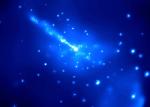 Centaurus A: X-Rays from an Active Galaxy
Centaurus A: X-Rays from an Active Galaxy
5.07.2003
Its core hidden from optical view by a thick lane of dust, the giant elliptical galaxy Centaurus A was among the first objects observed by the orbiting Chandra X-ray Observatory. Astronomers were not disappointed, as Centaurus A's appearance in x-rays makes its classification as an active galaxy easy to appreciate.
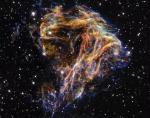 N49 s Cosmic Blast
N49 s Cosmic Blast
4.07.2003
Scattered debris from a cosmic supernova explosion lights up the sky in this gorgeous composited image based on data from the Hubble Space Telescope. Cataloged as N49, these glowing filaments of shocked gas span about 30 light-years in our neighboring galaxy, the Large Magellanic Cloud.
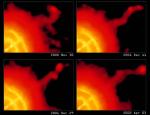 The Vela Pulsar s Dynamic Jet
The Vela Pulsar s Dynamic Jet
3.07.2003
The Vela pulsar is a neutron star born over 10,000 years ago in a massive supernova explosion. Above, false-color x-ray images from the Chandra Observatory reveal details of this remnant pulsar's x-ray bright nebula along with emission from a spectacular jet of high-energy particles.
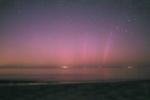 Aurora Over Cape Cod
Aurora Over Cape Cod
2.07.2003
Active pillars of colorful aurora were captured dancing over a serenely smooth and nearly colorless Cape Cod Bay last month. North is straight ahead so that the town lights near the center originate from Provincetown, Massachusetts, USA. The unusual red colors in the aurora slightly reflect off the ocean inlet.
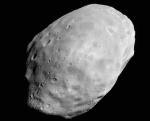 Martian Moon Phobos from MGS
Martian Moon Phobos from MGS
1.07.2003
Why is Phobos so dark? Phobos, the largest and innermost of two Martian moons, is the darkest moon in the entire Solar System. Its unusual orbit and color indicate that it may be a captured asteroid composed of a mixture of ice and dark rock.
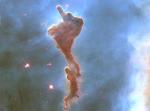 Disappearing Clouds in Carina
Disappearing Clouds in Carina
30.06.2003
This dense cloud of gas and dust is being deleted. Likely, within a few million years, the intense light from bright stars will have boiled it away completely. Stars not yet formed in the molecular cloud's interior will then stop growing.
 The Solar Spectrum
The Solar Spectrum
29.06.2003
It is still not known why the Sun's light is missing some colors. Shown above are all the visible colors of the Sun, produced by passing the Sun's light through a prism-like device.
 Messiers and Mars
Messiers and Mars
28.06.2003
A telescopic tour of the constellation Sagittarius offers the many bright clusters and nebulae of dimensioned space in a starscape surrounding the galactic center. This gorgeous color deep-sky photograph visits two such lovely sights, cataloged by the 18th century cosmic tourist Charles Messier as M8 and M20.
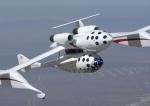 SpaceShipOne
SpaceShipOne
27.06.2003
Slung below its equally innovative mothership dubbed White Knight, SpaceShipOne rides above planet Earth, photographed during a recent flight test. SpaceShipOne was designed and built by cutting-edge aeronautical engineer Burt Rutan and his company Scaled Composites to compete for the X Prize.
|
January February March April May June July August September October November December |
|||||||||||||||||||||||||||||||||||||||||||||||||